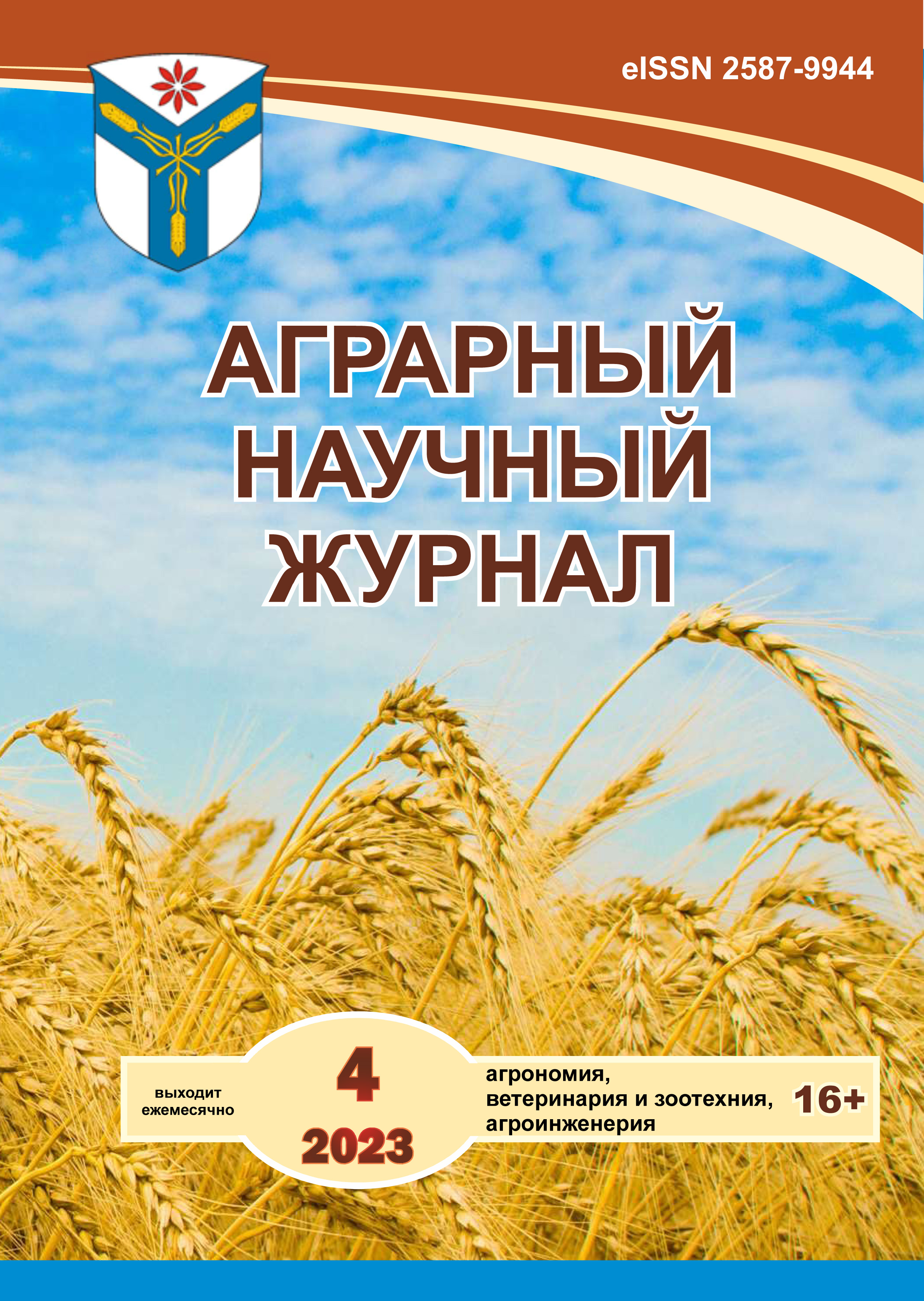Dynamics of growth and accumulation of heavy metals of Pisum Sativum L. grown on polluted soil (vegetative experience)
DOI:
https://doi.org/10.28983/asj.y2023i4pp20-27Keywords:
Pisum sativum L., SGECDt, heavy metals, growth ratesAbstract
The paper presents the results of studies of the effect of heavy metal salts (15 mg/kg CdCl2 and/or 50 mg/kg CoCl2) contamination of soddy-podzolic soil on the adaptive potential and phytoremediation activity of two pea genotypes contrasting in resistance: the cadmium-resistant mutant SGECDt and its wild line SGE. The experiment was carried out under laboratory conditions while maintaining a stable internal microclimate and an optimal degree of insolation in the room. The duration of the experiment was 85 days. A study of the dynamics of morphometric parameters, using the example of shoot and root biomass, showed that the SGECDt mutant demonstrated better resistance to toxicants: on average, the decrease in shoot biomass compared to control was 28.2%, and 5.5% for roots. Whereas on wild lines, the rates were 31.8% on shoots and 21.8% on roots, respectively. As expected, the tolerance of the mutant was best manifested in the variant with the introduction of cadmium ions. Thanks to mass spectrometric analysis, it was found that the content of cadmium in dry biomass of shoots increased with an increase in biomass in both genotypes. Moreover, in the mutant, it significantly exceeded the concentration of pollutant accumulation in the wild type, and practically did not change, starting from 30 days with separate or combined introduction of metals, and until the end of the growing season - 20-25 µg of dry biomass per gram of shoot. The content of cobalt, on the contrary, decreased in ontogenesis phases, with a slight superiority in metal fixation by the mutant, starting from 45 days after inoculation. With the simultaneous entry of both metals into the soil solution, synergism of action was not observed. The content of cobalt decreased even more in plants, while cadmium, on the contrary, increased. It can be concluded that the ion-exchange reactions between these pollutants differed in interactions in the "soil-plant" system by the type of antagonism. Among the optimal period for harvesting contaminated products for its further processing (phytomining), one can single out the budding phase - the beginning of flowering (45 days). During this period, the mutant plants simultaneously perform well detoxification (phytosanation) and active accumulation of atmospheric nitrogen in the soil.
Downloads
References
Алексеев Ю. В. Тяжелые металлы в почвах и растениях. Л., 1987. 142 с.
ГОСТ Р 58461-2019. Освещение растений в сооружениях защищенного грунта. Термины и определения. М., 2019. 19 с.
Государственный стандарт Союза ССР. Семена сельскохозяйственных культур. Методы определения всхожести. 12038-84. М.: Изд-во стандартов, 1985. 56 с.
Зубков Н. В. Влияние фосфорных удобрений на содержание тяжелых металлов в почве, поступление их в растения и продуктивность культур в условиях загрязнения почвы // Вестник Московского городского педагогического университета. Серия: «Естественные науки». 2011. № 2 (8). С. 71–84.
Колесников С. И., Казеев К. Ш., Вальков В. Ф., Пономарева С. В. Ранжирование химических элементов по их экологической опасности для почвы // Доклады Российской Академии сельскохозяйственных наук. 2010. Т. 1. С. 27–29.
Лаврентьева Г. В., Круглов С. В., Анисимов В. С. Динамика катионного состава почвенного раствора известкованной дерново-подзолистой почвы при загрязнении Co и Cd и изменении pH // Почвоведение. 2008. № 9. С. 1092–1100. DOI:10.1134/S106422930809007X.
Методические рекомендации по проведению полевых и лабораторных исследований почв и растений при контроле загрязнения окружающей среды металлом. М.: Гидрометеоиздат, 1981. 109 с.
Определение химических элементов в биологических средах и препаратах методами атомно-эмиссионной спектрометрии с индуктивно связанной плазмой и масс-спектрометрии: метод. указания. М.: Федеральный центр Госсанэпиднадзора Минздрава России, 2003. 56 с.
Потатуева Ю. А. Эколого-агрохимическая оценка фосфорных и фосфорсодержащих удобрений в длительных полевых опытах // Агрохимия. 2013. № 6. С. 83–94.
Пухальский Я. В., Лоскутов С. И. Мониторинг и прогнозирование динамики полива симбиотической системы гороха посевного на загрязнённой тяжёлыми металлами почве в условиях тепличного опыта // Известия Оренбургского государственного аграрного университета. 2017. № 6 (68). С. 240–245.
High Specificity in Response of Pea Mutant SGECDT to Toxic Metals: Growth and Element Composition / A. A. Belimov et al. // Environ. Exp. Bot. 2016. Vol. 128. P. 91–98. DOI: 10.1093/jxb/eru536.
The Crucial Role of Roots in Increased Cd-tolerance and Cd-accumulation in the Pea (Pisum sativum L.) Mutant SGECdt / A. A. Belimov et al. // Biol. Plant. 2018. Vol. 62. P. 543–550. DOI: 10.1007/s10535-018-0789-0
Microbial Consortium of PGPR, Rhizobia and Arbuscular Mycorrhizal Fungus Makes Pea Mutant SGECdt Comparable with Indian Mustard in Cadmium Tolerance and Accumulation / A. A. Belimov et al. // Plants. 2020. Vol. 9(8). P. 975. DOI: 10.3390/plants9080975.
Rhizobial ACC Deaminase Contributes to Efficient Symbiosis with Pea (Pisum sativum L.) under Single and Combined Cadmium and Water Deficit Stress / A. A. Belimov et al. // Environ. Exp. Bot. 2019. Vol. 167. P.103–859.
Pea marker database (PMD) – a new online database combining known pea (Pisum sativum L.) gene-based markers / O. A. Kulaeva et al. // PLoS ONE. 2017. Vol. 12. No. 10. P. 186–713. DOI: 10.1371/journal.pone.0186713.
Implications of chloride-enhanced cadmium uptake in saline agriculture: modeling cadmium uptake by maize and tobacco / U. J. L?pez-Chuken et al. // International Journal of Environmental Science and Technology. 2012. Vol. 9. P. 69–77. DOI: 10.1007/s13762-011-0018-2.
Cadmium pollution from phosphate fertilizers in arable soils and crops: an overview / A. G. Nino-Savala et al. // Frontiers of Agricultural Science and Engineering. 2019. No. 6 (4). P. 419–430. DOI: org/10.15302/J-FASE-2019273.
Sharakshane A. An easy estimate of the PFDD for a plant illuminated with white LEDs: 1000 lx = 15 ?mol/s/m2 // BioRxiv. 2018. https://doi.org/10.1101/289280.
A chemically induced new pea (Pisum sativum L.) mutant SGECdt with increased tolerance to and accumulation of cadmium / V. E. Tsyganov et al. // Annals of Botany. 2007. Vol. 99. P. 227–237. DOI: 10.1093/aob/mcl261.
Downloads
Published
Issue
Section
License
Copyright (c) 2023 The Agrarian Scientific Journal

This work is licensed under a Creative Commons Attribution-NonCommercial-NoDerivatives 4.0 International License.








